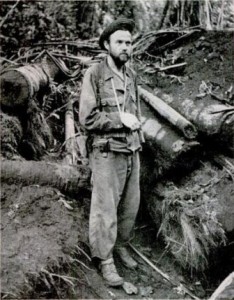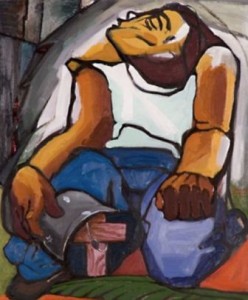Art vs. Tyranny: Pierre Daura, John Rossen, and Herman Bottcher
Pierre Daura, John Rossen, and Herman Bottcher—a Catalan painter, an American factory worker and a German carpenter—forged a close friendship in the trenches of Spain. A Japanese mortar round, a poem, and a painting united their lives, leaving a lasting artistic legacy.
In 1937-1938 three men’s lives intersected in war-torn Spain. The Spanish Civil War pitted Spaniard against Spaniard, and also brought together foreign volunteers. Within the International Brigades, three men—Pierre Daura, a Catalan, John Rossen, an American, and Herman Bottcher a German—apparently met, became friends, and influenced a remarkable work of art, prompted by their hatred of fascism.
Prior to the war, Pierre Daura was an artist living in France with his wife and daughter. When he went to Spain to fight Franco, he served as a forward observer for an artillery unit. Daura had a difficult time finding a unit to accept him. Due to an injury he sustained in the 1920s, the nerves to his left hand had been severed, leaving the hand permanently clenched. This disability resulted in his not being able to directly join the Republican forces. However, an officer in an anarchist unit fighting Franco met Daura in a café and indicated that the forward observer for his artillery had recently been killed. He was looking for a replacement. Daura mentioned he had served as an artilleryman prior to his disability. The officer immediately offered him the opportunity to join his unit. Two days later Daura was on his way to the front.
As for John Rossen and Herman Bottcher, both men had been living in the United States prior to the Spanish Civil War. Rossen was born in St. Louis, Missouri, while Bottcher was born in Landsberg, Germany and moved to the United States in 1931. Rossen worked in an automobile factory and Bottcher was a student and carpenter prior to volunteering with the Abraham Lincoln Brigade. Presumably, it was through their service in the Abraham Lincoln Brigade that they knew each other.
It is not known how and when Pierre Daura met Rossen and Bottcher. What is known is that the three men became linked upon Bottcher’s death during World War II and, going forward, Bottcher is remembered through Rossen’s and Daura’s intricate commemoration of him in poem and painting. In essence, a Japanese mortar round, a poem, and a painting united these men in a unique and quite fascinating manner.
Herman Bottcher lost his life on December 31, 1944, when a Japanese mortar round exploded on Leyte Isle in the Philippines. Bottcher had been operating with a group of American soldiers behind enemy lines, attacking Japanese supply depots and laying ambushes. They had been living off the land, eating wild game, vegetables, and coconut milk provided by Filipino natives. On December 30, 1944, Bottcher had been ordered to return with his men to HQ. At 2:35 a.m., December 31, approximately 300 Japanese soldiers stumbled onto Bottcher and his men as they attempted to retreat to the coast so that they could evacuate the island. The ensuing combat resulted in the Japanese firing a mortar round that exploded near Bottcher. It did not take his life immediately. Fellow soldier, Edwin Essman, recounted that Bottcher cried out: “They blew my leg off!” Bottcher told his men to retreat and leave him, but they refused and were able to extract him from the area. Ultimately, the medics were not able to save him, and around 6:00 a.m., December 31, 1944, reported “no sign of life could be detected.”
A fellow soldier recounted that Bottcher cried out: “They blew my leg off!”

Sergeant Herman Bottcher cut off Buna Village from Buna Mission during the Battle for Buna-Gona, Nov. 1942. Photo George Strock for Time/Life. Fair use.
In September 1945 John Rossen composed a poem to honor Bottcher and his struggle against fascism and tyranny during the Spanish Civil War and World War II. This poem reached Pierre Daura, and sometime in late 1945 or early 1946 he painted Pax Pacific. According to Daura’s daughter, Rossen’s poem directly inspired Daura in his artistic effort.
In Rossen’s poem, titled “Herman Bottcher, Summa Cum Laude,” Rossen chronicles Bottcher’s heroism and ultimate sacrifice (see http://cenphilsoc.brinkster.net/paxpacificpoem.htm). Using a formal education setting and the graduation ceremony as an extended metaphor, Rossen reveals how Bottcher serves as a model “for us the living” as he fought against fascism. Just as Bottcher “passed with flying colors” as his “Graduation exercise went off with a bang” (some gallows humor), we too are expected to graduate in a similar manner and die, if necessary, fighting fascism. As Rossen writes, referring to Bottcher:
We heard you say once to a frightened Spanish youngster
‘A real anti-Fascist must know how to die when necessary’
You were a real anti-Fascist, Butch
And you knew how to die when it became necessary.
Rossen also notes that Bottcher “is an ‘A’ forever and ever in the subject of anti-Fascist Geometry.” Bottcher received his “A” due to his heroic death and his consistent and dedicated struggle against fascism in two wars. The poem invites the reader to learn from Bottcher, who, in Rossen’s words, was “a great teacher” of “anti-Fascist Geometry.”
Knowing from Pierre Daura’s daughter that Rossen’s poem directly influenced her father when he created Pax Pacific, the painting takes on a deeper meaning. Knowing that the poem serves to commemorate Bottcher, we can comfortably surmise that the mourner in Pax Pacific is kneeling over Bottcher’s grave. We know that the setting is Leyte Isle. However, possibly most noteworthy is that certain symbolic elements in Daura’s painting may reinforce an overall message of sacrifice; that Bottcher sacrificed his life so others could live free from tyranny.
Symbolic elements in Daura’s painting reinforce an overall message of sacrifice: Bottcher sacrificed his life so others could live free from tyranny.
Several images included in the painting contain possible allusions to Christian iconography. The palm leaf stretched across the grave could be more than a simple reference to where Bottcher died, referring perhaps instead to Palm Sunday and Christ’s entering Jerusalem before his crucifixion. The cross, in addition to its placement at a soldier’s grave as a helmet rests on it, is a symbol for sacrifice and resurrection and a direct reference to Christ. The grey background may be a reference to Christ’s tomb. Through this symbolism Daura may be suggesting that Bottcher is a Christ-like figure. Interestingly, and possibly yet another reference to Christ, the mourner’s right hand is relaxed while his left is clinched.
Daura’s work strongly resembles depictions of Christ in works of art related to the last judgment. In Renaissance and Baroque last judgment paintings Christ generally forgives and offers salvation with his right hand while condemning sinners with his left. The mourner also looks to his right, upward, toward Heaven, possibly suggesting a favorable judgment upon Bottcher’s soul. I had the pleasure of interviewing Daura’s daughter, Martha, and she noted her father, being Spanish, had been raised as a Catholic and was intimately familiar with Christian iconography, and quite often included such symbolism in his work. It is likely this is the case with this painting.
However, as for the hands of the mourner, Martha thought the reference to Christ was possible—but she noted something that I think is more plausible. She told me how her father had lost the use of his left hand when a scaffold collapsed in the 1920s. When I told her how the mourner’s left hand is clenched, she literally gasped and stated that she had not noticed that before and that the mourner could be in some way a self-portrait of her father. The mourner’s left hand is clenched in the same manner as Daura’s left hand had been clinched since his accident. Coincidentally, in a manner that breaks with many of Daura’s paintings, where he signs his paintings in the bottom left or right corners, Daura signed Pax Pacific just to the right of the mourner’s left hand. This possibly provides another element indicating that the mourner is Daura himself. So is Pax Pacific a heretofore-unidentified self-portrait?
When I first examined the painting seven or eight years ago, I never imagined how my thoughts related to it would grow and change. The label that once hung next to the painting suggested the work somehow simply reflects on the loss that war brings. An almost pacific interpretation playing off of the title’s play on words, as both words relate to “peaceful” and “tranquil,” dominated the museum’s understanding of the work. Martha Daura’s sharing of an unpublished and basically unknown poem composed by John Rossen changed that. With this one important piece of the puzzle, a whole new interpretation and path of discovery was opened, resulting in the possibility that the painting is an abstract self-portrait.
At some level Pax Pacific accomplishes something Daura may not have intended. Pax Pacific provides a vehicle to inspire questioning which in and of itself is a stand against fascism and tyranny. To question is to challenge. Tyranny cannot allow this. And either consciously or subconsciously, through Pax Pacific, Daura created something that begs viewers to stand up to tyranny. The painting begs us to question.
B. Scott Crawford is an adjunct history instructor with Virginia Western Community College in Roanoke, Virginia.















Diegene die in de Spaanse Burgeroorlog vochten volgden hun geweten, ze waren anti-fascistisch, tegen tirannie en hadden Sociale idealen, nu anno 2022 kun je idealen wel vergeten, de Mensheid is afhankelijk geworden of de systemen van de Aarde verslechteren of stabiliseren, het wordt echte nooit meer zoals het was, de kans wordt echter groter dat de tirannie weer terug komt en er weer een beroep op ons geweten zal worden gedaan, om weer tegen de tirannie te vechten!